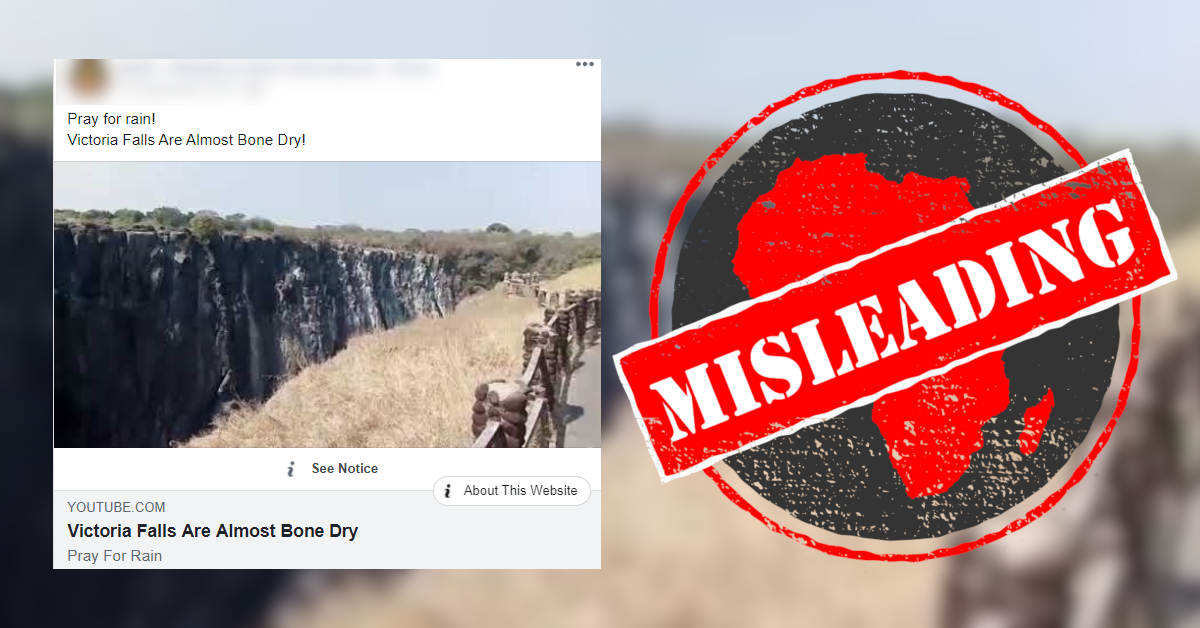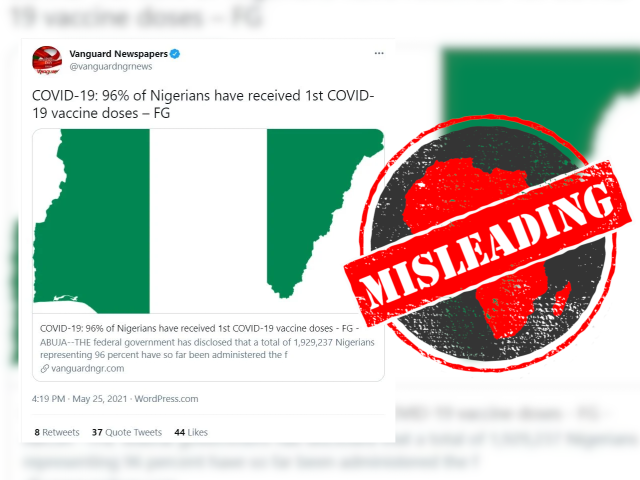“Victoria Falls are almost bone dry.” That’s the claim made in a YouTube video posted on 26 September 2019 and shared nearly 1,300 times on Facebook.
The video was shot by a person claiming to be viewing Victoria Falls from the Livingstone, Zambia side of the waterfall. The waterfall is on the Zambezi River, which forms the border between Zambia to the north and Zimbabwe to the south.
The video shows that the waterfall is mostly dry rock face, with only two or three narrow streams of water flowing down. The person, off camera, refers to Victoria Falls as “Victoria Rocks” and urges viewers to pray for rain.
International news organisations such as BBC News, the Guardian, and Sky News all published stories in November and December 2019 reporting that the waterfall had shrunk to its lowest levels in 25 years and was at risk of drying up completely.
Southern Africa has been gripped by its worst drought in several decades, leading to food shortages in countries like Zambia and Zimbabwe. Is the drought leading to Victoria Falls drying up completely? We investigated.

The footage in the YouTube video appears to be genuine. But the Zambezi River is subject to seasonal fluctuations, with water volumes peaking between April to June and lowering significantly from October to late December.
The Zambezi River Authority is jointly owned by Zimbabwe and Zambia and maintains the Kariba Dam on the Zambezi River, downstream from Victoria Falls. It published a graph showing that the Zambezi River annual water flows for 2018/19 were the lowest since 1995/96 year.
The graph shows that the water flows from November to December 2019 were only slightly lower than water flows from previous years, and still well above the 1995/96 levels.
The African Travel and Tourism Association said in a 10 December press release that regular seasonal fluctuations mean that the waterflow on the Zambian side of the waterfall does slow until dry rock face is visible while on the Zimbabwean side a “reasonable flow of water” is still visible.
While water levels had been lower in the six previous years, it said, they were expected to rise to normal levels.
The website Victoria Falls Guide has published pictures of the waterfall taken at different angles on 4 November 2014 which show areas where the rock face is almost completely dry.
Travel guides to Victoria Falls advise travellers that the Zambian side of the river may dry up completely during the dry season.
A segment aired on the US television show Good Morning America on 19 February 2020 showed Victoria Falls had returned to its full glory. There was much more water in the waterfall than five months earlier and it lived up to its name Mosi-oa-Tunya, “the smoke that thunders”.
While Southern Africa is experiencing drought, the great Victoria Falls has not dried up. – Naledi Mashishi
The video was shot by a person claiming to be viewing Victoria Falls from the Livingstone, Zambia side of the waterfall. The waterfall is on the Zambezi River, which forms the border between Zambia to the north and Zimbabwe to the south.
The video shows that the waterfall is mostly dry rock face, with only two or three narrow streams of water flowing down. The person, off camera, refers to Victoria Falls as “Victoria Rocks” and urges viewers to pray for rain.
International news organisations such as BBC News, the Guardian, and Sky News all published stories in November and December 2019 reporting that the waterfall had shrunk to its lowest levels in 25 years and was at risk of drying up completely.
Southern Africa has been gripped by its worst drought in several decades, leading to food shortages in countries like Zambia and Zimbabwe. Is the drought leading to Victoria Falls drying up completely? We investigated.

Seasonal fluctuations are normal
The footage in the YouTube video appears to be genuine. But the Zambezi River is subject to seasonal fluctuations, with water volumes peaking between April to June and lowering significantly from October to late December.
The Zambezi River Authority is jointly owned by Zimbabwe and Zambia and maintains the Kariba Dam on the Zambezi River, downstream from Victoria Falls. It published a graph showing that the Zambezi River annual water flows for 2018/19 were the lowest since 1995/96 year.
The graph shows that the water flows from November to December 2019 were only slightly lower than water flows from previous years, and still well above the 1995/96 levels.
The African Travel and Tourism Association said in a 10 December press release that regular seasonal fluctuations mean that the waterflow on the Zambian side of the waterfall does slow until dry rock face is visible while on the Zimbabwean side a “reasonable flow of water” is still visible.
While water levels had been lower in the six previous years, it said, they were expected to rise to normal levels.
The website Victoria Falls Guide has published pictures of the waterfall taken at different angles on 4 November 2014 which show areas where the rock face is almost completely dry.
Travel guides to Victoria Falls advise travellers that the Zambian side of the river may dry up completely during the dry season.
A segment aired on the US television show Good Morning America on 19 February 2020 showed Victoria Falls had returned to its full glory. There was much more water in the waterfall than five months earlier and it lived up to its name Mosi-oa-Tunya, “the smoke that thunders”.
While Southern Africa is experiencing drought, the great Victoria Falls has not dried up. – Naledi Mashishi
Republish our content for free
For publishers: what to do if your post is rated false
A fact-checker has rated your Facebook or Instagram post as “false”, “altered”, “partly false” or “missing context”. This could have serious consequences. What do you do?
Click on our guide for the steps you should follow.
Publishers guideAfrica Check teams up with Facebook
Africa Check is a partner in Meta's third-party fact-checking programme to help stop the spread of false information on social media.
The content we rate as “false” will be downgraded on Facebook and Instagram. This means fewer people will see it.
You can also help identify false information on Facebook. This guide explains how.




Add new comment